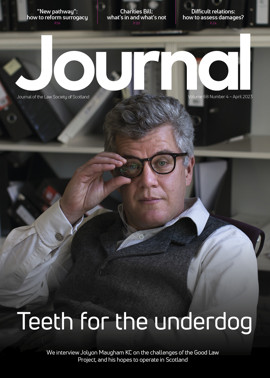A Scottish Environment Court: breaking new ground?

The question of the establishment of an environmental court or tribunal (“ECT”) in Scotland has persisted for many years. The time has come round again for the Scottish Government to review and address the growing gaps in environmental governance. The current system is fragmented and this article argues that a dedicated Scottish Environment Court would improve access to justice, provide better remedies, and bring judicial certainty.
Forthcoming consultation
In the aftermath of Brexit, Environmental Standards Scotland (“ESS”) was established under the UK Withdrawal from the European Union (Continuity) (Scotland) Act 2021. However, the powers of ESS are very limited compared to the powers of the European Commission pre-Brexit. The publication of the ESS strategic plan in November 2022 triggers the duty under s 41 of the 2021 Act to consult on “whether the law in Scotland on access to justice on environmental matters is effective and sufficient, and whether and, if so, how the establishment of an environmental court could enhance the governance arrangements”. This consultation must commence no later than the end of May 2023. It will be key to any decision on whether an ECT will be incorporated into the Scottish legal system and, if so, how the court will be structured.
ERCS and its work
The Environmental Rights Centre for Scotland (“ERCS”) was established in 2020 to assist the public and civil society to understand and exercise their rights in environmental law and to protect the environment. It has four areas of work: awareness raising of legal rights and remedies; advocacy in policy and law reform; strategic public interest litigation; and in 2021, ERCS launched Scotland’s only free legal advice service on environmental and related planning law, with the aim of increasing access to justice and holding public authorities and polluters to account on the environment. In its first 18 months the service received over 150 enquiries.
A key objective for ERCS’s advocacy is to establish a dedicated Scottish Environment Court. The case for an ECT in Scotland is clearly outlined in Why Scotland needs an environmental court or tribunal (ERCS/Christman, 2021), and most recently by Professor Campbell Gemmell in The clear and urgent case for a Scottish Environment Court, both published on ercs.scot.
Access to justice
The many barriers to access to justice are the most compelling argument in favour of the creation of an ECT. Scotland is in breach of article 9(4) (access to justice) of the Convention on Access to Information, Public Participation in Decision-making and Access to Justice in Environmental Matters (the Aarhus Convention), and is required to produce an action plan to achieve compliance by October 2024. A court with a comprehensive jurisdiction would enable appropriate, fair, equitable, timely and not prohibitively expensive access to justice and go some way to achieve full compliance with the Aarhus Convention.
Lessons from other jurisdictions
The consultation on the effectiveness of environmental governance is an opportunity to consider what an effective ECT in Scotland would look like. Given the growing number of ECTs around the world, there could not be a better time to learn from the experiences of other jurisdictions.
Some excellent examples are the Land & Environment Court of New South Wales (“LECNSW”), and the Environmental Court of New Zealand (“ECNZ”), as well as the Swedish Land & Environment Courts. The aspects which determine their success are their jurisdiction, their remedies, how they place the burden of proof, the expertise of judges and members of the court, and the use of alternative dispute resolution processes.
Jurisdiction
Broad jurisdiction means a court can hear disputes at different levels – an ECT can have civil, administrative and criminal jurisdiction, and/or original and appellate jurisdiction. The LECNSW has one of the broadest defined jurisdictions, which includes merits review, judicial review, civil enforcement, criminal prosecution, and civil claims about planning, land, and other legislation. The Environment & Land Court of Kenya is another example of a specialised court which has original and appellate jurisdiction to hear disputes related to land and the environment. The ECNZ is an appellate court, therefore much of its workload comes from appeals brought against decisions of local authorities. A Scottish Environment Court with broad jurisdiction could effectively respond to the multi-faceted nature of environmental disputes.
Burden of proof
Environmental courts have displaced traditional burdens of proof. Case law from the LECNSW establishes that it is not necessary for serious or irreversible environmental damage to have occurred – simply the threat of such damage may be enough, coupled with the condition that the damage passes the threshold of serious or irreversible: Telstra Corporation Ltd v Hornsby Shire Council [2006] NSWLEC 133. A similar approach was taken by a Chinese regional environmental court in the case of Guiyang (discussed in Wang and Gao, Journal of Court Innovation, vol 3 (2010), 37), where the plaintiff was only required to demonstrate that pollution of a local drinking water source had occurred, not that a duty of care existed on the part of the defendant. A Scottish Environment Court could introduce new standards of burden of proof which ensure equity.
Remedies
Access to justice can be measured by an assessment of the remedies available. Remedies can vary, depending on the type of dispute, and an environmental dispute can often encompass many issues which require separate remedies, such as environmental damage, damage to human health or economic loss. Equally, the lack of adequate remedies can act as a deterrent to persons who wish to bring a case to court.
ECTs are known to develop innovative remedies and holistic solutions to environmental disputes. The ECTs of India utilise innovative remedies such as “continuing mandamus”, which is the power to continue having oversight of a case after it has concluded, to ensure full compliance with the decision. Access to justice in Scotland would be improved by an ECT which could provide far-reaching remedies, with long-term effects, tailored to the often multi-faceted issues in environmental disputes (cf D Smith, “Environmental courts and tribunals: changing environmental and natural resources law around the globe”, Journal of Energy and Natural Resources Law, vol 36 (2018), issue 2).
Environmental law expertise
Countries which have not established ECTs face problems arising from the lack of expertise of generalist judges who preside over environmental disputes. Some ECTs have multidisciplinary teams sitting during trials; others provide specialist training to judges; and there are ECTs which employ full time, law-trained justices and part time, technical experts with scientific background.
In Sweden, an ECT has a panel of one law-trained judge, one environmental technical adviser, and two lay expert members (Anker and Nilsson, “The Role of Courts in Environmental Law – Nordic Perspectives”, Journal of Court Innovation, vol 3 (2010), 111). The judge and the technical adviser are employed by the court on a permanent basis, while the lay members are nominated by the industry and central public authorities. The use of technically-trained judges has improved the quality of environmental judgments – the collective approach has led to a better understanding of expert evidence, and the panel is equipped to ask the right questions during hearings: see Domenico Amirante’s “Preliminary Reflections on the National Green Tribunal of India”, Pace Environmental Law Review, vol 29 (2012), 441). A Scottish Environment Court could benefit from employing a similar approach to improve environmental law expertise in the judiciary.
Alternative dispute resolution
Some of the most successful and effective ECTs in the world have recognised that the complex nature of environmental disputes may be served well by the flexibility of alternative dispute resolution. In Australia, ECTs have adopted less adversarial and more informal alternatives to trials, such as mediation, conciliation, and neutral evaluation. The LECNSW, which hosts several ADR processes, has been described as operating a “multi-door courthouse”: B Preston, “Characteristics of successful environmental courts and tribunals”, Journal of Environmental Law, vol 26 (2014), 365.
The Planning & Environment Court of Queensland is unique in its appointment of an ADR Registrar – an environmental law practitioner who assists the parties to find a resolution in a collaborative manner. The ADR processes are undertaken early in the case, even from the very outset, and approximately 60-70% of all cases are settled with the help of the ADR Registrar (Preston, cited above). A Scottish Environment Court could adopt a similar process for more effective, timely and affordable remedies.
Conclusion
The forthcoming review and consultation on environmental governance has the potential to introduce transformational change in reducing the barriers to access to justice and improving judicial processes. A Scottish Environment Court with a comprehensive jurisdiction would act as a one-stop shop, with permanent expertly trained judges, far-reaching remedies, enforcement powers, and a flexible, tailor-made approach to dispute resolution.
The two main texts drawn on by this article for information on courts in other jurisdictions are the Preston article, cited above, and George and Catherine Pring, Environmental Courts and Tribunals – 2021: A Guide for Policy Makers, UNEP
Perspectives
Features
Briefings
- Criminal court: Towards proper control
- Planning: NPF4 – an emerging housing issue
- Insolvency: Court confirms overseas winding up approach
- Tax: R&D relief – welcome changes but outlook uncertain
- Immigration: Family reunions given new rules
- Scottish Solicitors' Discipline Tribunal
- In-house: Support to suit







